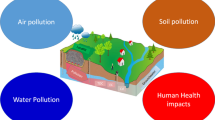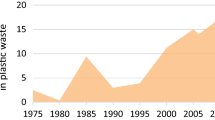Abstract
Background, aim, and scope
In recent years, besides being recycled domestically, a part of Japanese post-consumer polyethylene terephthalate (PET) bottles have been exported to and recycled in mainland China. In this study, life-cycle assessment (LCA) was applied to compare domestic and transboundary recycling scenarios between Japan and China and disposal scenarios from the viewpoints of greenhouse gases (GHG) emission and fossil resource consumption.
Methods
The following 10 scenarios based on our field surveys were evaluated: Japanese post-consumer PET bottles are (i) recycled into polyester staple in Japan, (ii) recycled into polyester filaments in Japan, (iii) recycled into polyester clothes in Japan, (iv) chemically decomposed and recycled into bottle-grade PET resin in Japan, (v) chemically decomposed and recycled into polyester filaments in Japan, (vi)–(vii) recycled into polyester staple via two different flows in China, (viii) recycled into polyester clothes in China, (ix) incinerated and partly recovered as electricity in Japan, and (x) directly landfilled in Japan. In all the evaluated scenarios, the functional unit is the recycling or disposal of 1 kg of Japanese post-consumer PET bottles. The system boundaries range from waste collection by municipalities to the manufacture of recycled products that can be regarded as substitutes for virgin products, and a credit for the avoided production of equivalent virgin products is given to each scenario. The inventories of both foreground and background processes in Japan were quoted from published reports and databases. The actual conditions of PET bottle recycling that were obtained through field surveys in China were reflected to some inventories of foreground processes in China. The inventories of public electricity supplies in China were based on the national statistics, and the inventories of petroleum products, industrial water supply, and waste treatment are based on our field surveys in China. Other unknown inventories in China were substituted by corresponding inventories in Japan.
Results and discussion
The results showed that all the domestic and transboundary recycling scenarios had smaller GHG emissions and fossil resource consumptions than the incineration scenario and that the chemical recycling scenarios had larger GHG emissions and fossil resource consumptions than the other recycling scenarios. The landfilling scenario had the largest fossil resource consumption, while it was better than the incineration scenario and slightly better than the chemical recycling scenarios from the viewpoint of GHG emission. The robustness of the results was examined, and it was found that the differences in GHG emission and fossil resource consumption between the domestic and transboundary recycling scenarios, other than the scenarios including cloth-manufacturing processes in system boundaries, were sufficiently large to be robust against the variability of background parameters for electricity supplies. As for the variability against the substitutions between recycled products and virgin products, interchanging the producer countries of substituted virgin products decreases the GHG emissions and fossil resource consumptions of the domestic recycling scenarios, but increases those of the transboundary scenarios.
Conclusions
When recycling systems between different countries are compared using LCA, it should be noted that the differences in background parameters have an impact on the environmental burdens of recycling and avoided manufacturing processes, and therefore, the result depends on the identification of the producer countries of the virgin products that are substituted by recycled products. However, it is practically impossible to identify in which country the manufacture of virgin products are avoided by recycling. Therefore, it is recommended that the results be presented according to the relationships between recycled and substituted virgin products as described in this paper.





Similar content being viewed by others
References
Arena U, Mastellone ML, Perugini F (2003) Life cycle assessment of a plastic packaging recycling system. Int J Life Cycle Assess 8(2):92–98
Bjorklund A, Finnveden G (2005) Recycling revisited—life cycle comparisons of global warming impact and total energy use of waste management strategies. Resour Conserv Recycl 44:309–317
Council for PET Bottle Recycling, Japan (2008) Annual report for PET bottle recycling 2008. http://www.petbottle-rec.gr.jp/top.html
Ekvall T (2000) A market-based approach to allocation at open-loop recycling. Resour Conserv Recycl 29:91–109
Ekvall T, Finnveden G (2001) Allocation in ISO 14041—a critical review. J Clean Prod 9:197–208
Ekvall T, Weidema BP (2004) System boundaries and input data in consequential life cycle inventory analysis. Int J Life Cycle Assess 9(3):161–171
Frees N (2008) Crediting aluminum recycling in LCA by demand or by disposal. Int J Life Cycle Assess 13(3):212–218
Fujii M, Murakami S, Nansai K, Hashimoto S, Moriguchi Y, Nakamura T, Koshikawa T (2007) Transportation cost survey on sorted collection of municipal solid waste. Journal of the Japan Society of Waste Management Experts 18(6):443–453
Fukushima Y, Hirao M (1998) Lifecycle model for PET bottle recycle system evaluation. Transaction of IEE of Japan 118-C(9):1250–1256
Intergovernmental Panel on Climate Change: IPCC (2001) IPCC Third Assessment Report—Climate Change 2001: synthesis report. Working Group I—Technical Summary, C.6. http://www.grida.no/publications/other/ipcc_tar/
International Energy Agency: IEA (1999) IEA statistics: CO2 emissions from fuel combustion 1971–1997. IEA, Paris
Japan PET Bottle Association, Industrial Information Research Center (2004) Report for inventory analysis of PET bottles
Kobayashi K, Tahara K, Sagisaka M, Wei B, Bi J (2008) Issues on development of Chinese inventory database. The 8th International Conference on EcoBalance Proceedings: P-021
Life Cycle Assessment Society of Japan: JLCA (2008) JLCA LCA database 2008 4th edition. http://www.jemai.or.jp/lcaforum/db/01_01.cfm
Matsuda S, Kubota H (2008) LCA analysis of PET bottle recycling by using proposed concept of social energy consumption. Journal of Life Cycle Assessment, Japan 4(1):67–77
National Bureau of Statistics, People’s Republic of China, National Development and Reform Commission, People’s Republic of China (2007) Chinese energy statistical yearbook—2006
Perugini F, Mastellone ML, Arena U (2005) A life cycle assessment of mechanical and feedstock recycling options for management of plastics packaging wastes. Environ Prog 24(2):137–154
Romero-Hernandez O, Romero-Hernandez S, Munoz D, Detta-Silveira E, Palacios-Brun A, Laguna A (2009) Environmental implications and market analysis of soft drink packaging systems in Mexico. A waste management approach. Int J Life Cycle Assess 14(2):107–113
Sugiyama H, Hirao M, Mendivil R, Fischer U, Hungerbuhler K (2006) A hierarchical activity model of chemical process design based on life cycle assessment. Process Saf Environ Prot 84(B1):63–74
Tokai A, Furuichi T (2000) Evaluation of recycling policies for PET bottles based on multiattribute utility indices. Journal of Material Cycles and Waste Management 2:70–79
Acknowledgments
This research was supported by a Grant-in-Aid for Scientific Research of Waste Management from the Japanese Ministry of the Environment. The authors gratefully acknowledge valuable information provided by Hirokazu Hayashi (Industry-Information Collaboration Research Center Corp.) and Fumio Tanaka (Nippon Oil Research Institute, Co., Ltd.). The authors are also grateful to the anonymous Japanese and Chinese recyclers who provided valuable information.
Author information
Authors and Affiliations
Corresponding author
Additional information
Responsible editor: Shabbir Gheewala
Electronic supplementary material
ESM 1
(DOC 192 kb)
Rights and permissions
About this article
Cite this article
Nakatani, J., Fujii, M., Moriguchi, Y. et al. Life-cycle assessment of domestic and transboundary recycling of post-consumer PET bottles. Int J Life Cycle Assess 15, 590–597 (2010). https://doi.org/10.1007/s11367-010-0189-y
Received:
Accepted:
Published:
Issue Date:
DOI: https://doi.org/10.1007/s11367-010-0189-y




